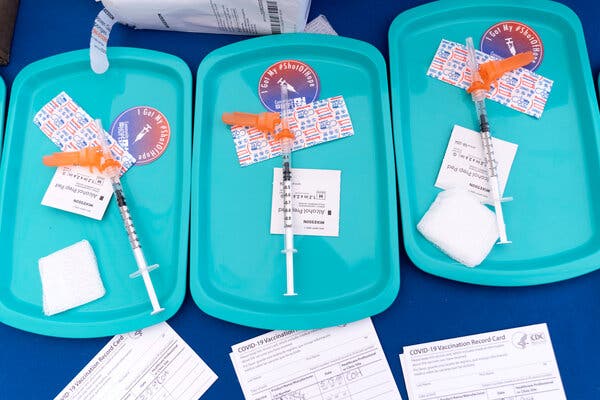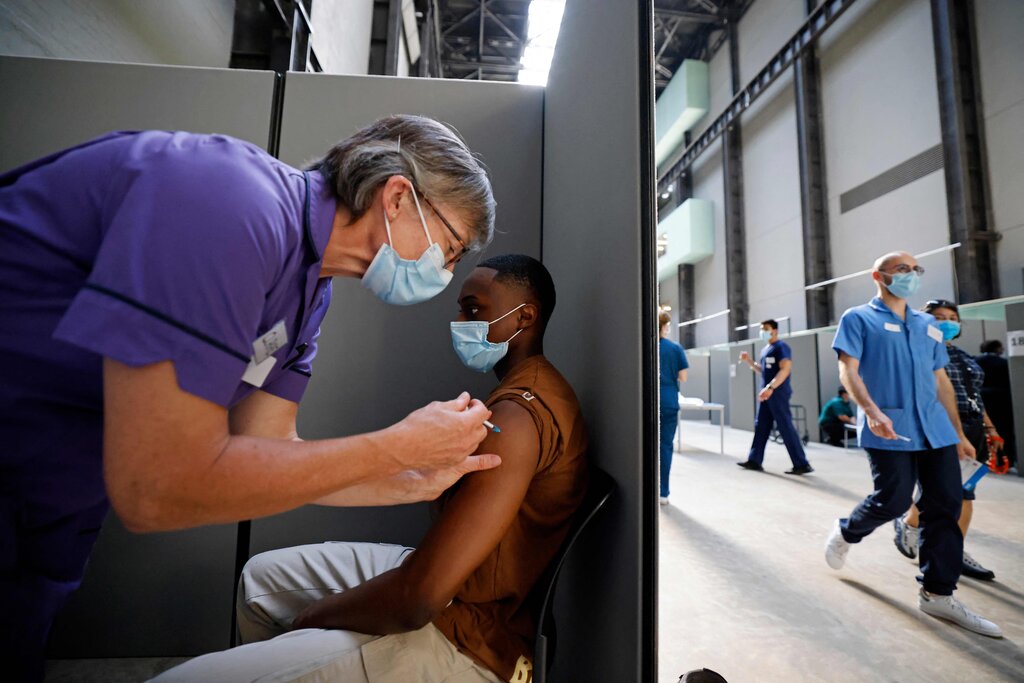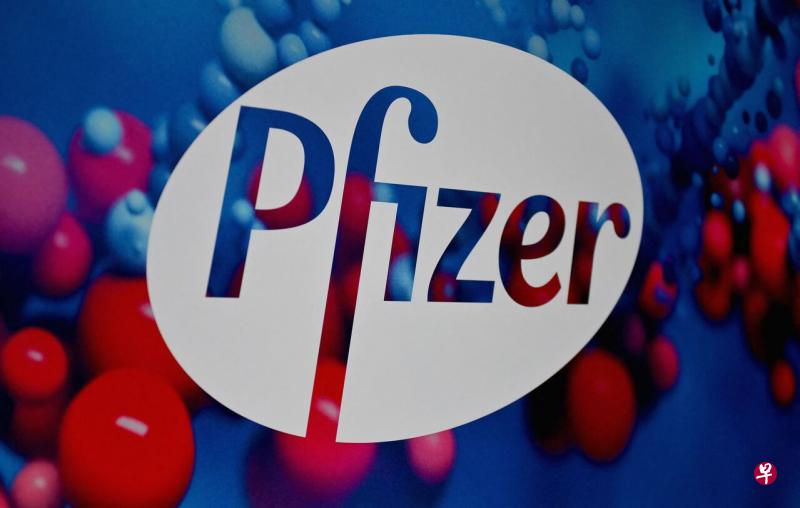A New Vaccine Strategy for Children: Just One Dose, for Now
Myocarditis, a rare side effect, occurs mostly after the second dose. So in some countries, officials are trying out single doses for children.
By Apoorva Mandavilli
10/08/2021

Even as parents in the United States wrestle with difficult questions over vaccinating their children against the coronavirus, families in other countries have been offered a novel option: giving children just one dose of the vaccine.
Officials in Hong Kong as well as in Britain, Norway and other countries have recommended a single dose of the Pfizer-BioNTech vaccine for children ages 12 and older — providing partial protection from the virus, but without the potential harms occasionally observed after two doses.
Health officials in those countries are particularly worried about increasing data suggesting that myocarditis, an inflammation of the heart, may be more common among adolescents and young adults after vaccination than had been thought.
The risk remains very small, and significant only after the second dose of an mRNA vaccine. But the numbers have changed the risk-benefit calculus in countries where new infections are mostly lower than in the United States.
Advisers to the Centers for Disease Control and Prevention reviewed data on myocarditis in June, and unanimously voted to recommend the vaccine for children ages 12 and older, saying the benefits far outweighed the risk.
Agency research has estimated that for every million vaccinated boys ages 12 to 17 in the United States, the shots might cause a maximum of 70 myocarditis cases, but they would prevent 5,700 infections, 215 hospitalizations and two deaths. Studies have also shown that the risk of heart problems after Covid-19 is much higher than after vaccination.
Myocarditis was among the concerns that led the Food and Drug Administration to ask vaccine makers this summer to increase the number of children in clinical trials. The issue is likely to be the focus of intense discussion when agency advisers meet later this month to review the evidence for vaccinations of children ages 5 to 11.
The latest analysis, which was published on Wednesday in The New England Journal of Medicine, found that the incidence of myocarditis after vaccination in Israel was highest among males aged 16 to 29. About 11 of every 100,000 males in that age group developed the condition a few days after being vaccinated, a rate higher than most earlier estimates. (The risk was negligible in females of any age.)
Of the 54 cases identified in the study, one was severe enough to require ventilation. Another patient with a history of heart disease died of an unknown cause soon after discharge from the hospital.
Of the 14 patients in the new study who showed heart abnormalities when they were admitted to the hospital, 10 still had some signs of problems when they were discharged. But when the patients were examined again a few weeks later, all five of those for whom results were available appeared to have fully recovered.
A second study, which was also published in the journal, found that boys between 16 and 19 years of age had the highest incidence of myocarditis after the second dose — nine times as high when compared with unvaccinated boys of the same age during the same time.
Health officials in other countries plan to revisit the one-dose strategy as more safety information becomes available, and they may choose to proceed with second shots. But the possibility of deferring the second jab has not received enough attention in the United States, said Dr. Walid Gellad, a drug safety expert at the University of Pittsburgh.
“In the U.S., people have not wanted to talk about it, for unclear reasons,” Dr. Gellad said. “Parents who are hesitant may appreciate the fact that the risk of side effects is actually much lower for one dose than it is for two doses.”
Serious side effects have primarily been seen in boys, so the dosing calculus should be different for boys and girls, he added.

It is too early to know whether myocarditis might permanently weaken the hearts of some people after vaccination, said Dr. Jeremy Brown, an expert in respiratory diseases at University College London and a member of Britain’s vaccine advisory group.
“That makes it very hard for us to make the absolute statement that it’s totally safe to give this vaccine,” Dr. Brown said. “We need some feel for what the long-term consequences of the myocarditis might be.”
The urgency of fully vaccinating children with two doses has to be weighed for each country’s particular situation, experts said. In Britain, high rates of vaccination among older and high-risk adults have helped to keep hospitals mostly free of patients severely ill with Covid-19.
“The chance of getting severe Covid in a healthy 12- to 15-year-old is almost negligible,” Dr. Brown said. “Against that, you have to make sure that the vaccine that you’re giving is utterly safe.”
Some experts have argued that immunizing children would help to sever chains of transmission and contain the virus. But immunizing children to protect others — when there may be a risk to the recipient, however small — was indefensible, Dr. Brown said.
“You don’t vaccinate a 15-year-old to prevent them infecting other adults — that’s not morally, ethically the right thing to do,” he said.
In Hong Kong, the argument for double-dosing adolescents is even weaker than in Britain, said Benjamin Cowling, an epidemiologist at the University of Hong Kong.
Hong Kong has recorded only 213 deaths and just over 12,000 cases of Covid-19 since the start of the pandemic, with fewer than 10 cases per day since April. So the risk of myocarditis, however rare, outweighs the benefit of fully vaccinating adolescents, Dr. Cowling said.
Clinical trials of the vaccine in children are not large enough to detect rare side effects like myocarditis, he added. “You’d only see it when it goes to the population level, and then it’s too late.” Whether to offer second doses to children “does need a careful consideration.”

But the United States is not in same position as other countries, noted Dr. Jeffrey Duchin, an infectious diseases physician and a nonvoting member of the C.D.C.’s advisory group on vaccines.
About 2,000 Americans are dying every day, and hospitals in many parts of the country are still packed. “We’ve had a significant impact on our pediatric population,” Dr. Duchin said.
More than 63,000 children were hospitalized with Covid-19 from August 2020 to October 2021, and at least 520 have died. Some children have developed so-called long Covid-19, in which symptoms can persist for months, and more than 4,000 have been diagnosed with a dangerous condition called multisystem inflammatory syndrome in children.
“All the data that we have so far suggests the disease itself is significantly worse than the vaccine side effects,” Dr. Duchin said. Given all of that, a small risk of myocarditis is well worth taking, he said, and two doses are justified.
Dr. Duchin said he also had some concerns that one dose of the vaccine might not shield children against infection or illness — at least, not for long. “I just have not seen data that would suggest that one dose would have a durable and high level of protection,” he said.
All of these concerns, as well as the data on myocarditis, should inform a national conversation about the wisdom of offering one dose versus two shots to adolescents, some experts said.
“There hasn’t been enough discussion about the potential harms of vaccination, because everybody is very, very sensitive about hesitancy and doesn’t want to give any fuel to anti-vaccination campaigns,” Dr. Cowling said.
In the United States, in particular, many public health experts have been reluctant to voice concerns about the vaccines, Dr. Gellad said: “No one wants to introduce any doubt that kids should be vaccinated. But I think there are ways to talk about it that will appeal to people who are hesitant.”
Kristina Rogers, a 51-year-old mother of two in Oklahoma, said she would welcome the option to give her 12-year-old daughter only one dose of the vaccine.
Ms. Rogers, who is fully immunized, worries that not enough was known about the vaccines’ long-term effects in children and said she wished there were more open discussion.
Ms. Rogers has diabetes and developed chronic kidney disease after a severe bout with Covid last year. She lost her brother-in-law to Covid a year ago.
But the two doses of vaccine left her feeling flattened and fatigued, as well, and she worried the shots might prove too much for her children. They wear masks at school and wash their hands regularly, but Ms. Rogers and her husband are not yet ready to vaccinate them.
“The last thing you want to do is mess with their ticker, man — that’s what makes them go,” she said. “I would be more up for the one dose, if that was an option.”
Correction:
An earlier version of this article incorrectly described actions taken by regulators in Sweden and Denmark. They have halted use of the Moderna vaccine in children; they have not begun offering single doses. The article also misstated the number of Covid hospitalizations in U.S. children. It is more than 63,000 from August 2020 to October 2021, not 900,000 since the beginning of the pandemic. In addition, the article misstated the timing of an F.D.A. meeting on authorization of the Pfizer-BioNTech vaccine for children. It is later this month, not next week.
诚招美国和加拿大法律服务代理
因公司发展需要,诚招美国和加拿大法律服务代理。
要求:
懂英语、或西班牙语、或法语。
能合法工作有社安号或工号。
无需改行, 可以兼职。
大学生和有销售经验优先考虑。
自雇生意公司发美国报税1099,加拿大T4A
有意了解详情, 请扫码加微信, 非诚勿扰!

辉瑞向FDA申请疫苗在5至11岁的儿童中紧急使用
文 / 林煇智
10/07/2021

(早报讯)辉瑞公司和BioNTech公司周四(7日)表示,他们已经要求美国食品药物管理局批准辉瑞疫苗在5至11岁的儿童中紧急使用。
路透社报道,美国食品和药物管理局已将10月26日定为外部顾问开会讨论辉瑞公司申请的日期。这意味,孩子们有可能在不久之后开始接受疫苗。
由于全国范围内的学校已经开学,快速授权可以帮助缓解今年秋季可能出现的病例激增。在这之际,美国儿科学会的数据显示,冠病在儿童中的感染率飙升,在9月初达到了大流行的最高点。
两家公司在9月20日说,这种疫苗已经被授权用于12至15岁的儿童,并被完全批准用于16岁及以上的青年。在一项有2268名参与者的临床试验中,这种疫苗已经被证明能在目标年龄组中产生强烈的免疫反应。
据报道,辉瑞疫苗在该公司申请授权后约一个月就被授权用于12-15岁的儿童。
虽然孩子们对严重的冠病不太敏感,但他们可以将病毒传播给其他人,包括更容易患严重疾病的弱势人群。
Schools grapple with thousands in isolation or quarantine as delta variant rages
Many schools that planned to forgo virtual and hybrid learning this year, in favor of in-person classes, are revisiting those plans as outbreaks require students to quarantine.
By Daniella Silva
9/05/2021

Schools that have opened their doors to students amid the spread of the highly contagious delta variant of the coronavirus already are grappling with how to best continue teaching students when hundreds and sometimes thousands of them are in quarantine.
As cases of Covid-19 started to wane over the spring and the early summer, many schools planned to forgo virtual and hybrid learning this year, in favor of in-person classes. But the lag in vaccination rates and the rapid spread of the delta variant have led districts to revisit those plans, with varying results.
Some schools have sent students home with packets of self-guided work to submit at the end of each day or when on-campus classes resume. Others have temporarily switched to virtual learning. And in some cases, schools have canceled classes altogether while campuses are closed or kids are in quarantine.

In Mississippi, officials last month said more than 20,000 students were in quarantine from exposure to the coronavirus after the first week of school.
The high quarantine numbers among students and staff members led at least 29 schools to “go virtual for a short time in order to interrupt transmission,” the state’s epidemiologist said.
Similarly, the Connally Independent School District in Texas, which opened to students Aug. 18, closed its schools for in-person classes Tuesday after two teachers died last week of Covid. The five schools in the suburban Waco district hastily switched to remote learning and are scheduled to reopen for in-person learning after Labor Day.
“If this pandemic has taught us one thing, it is the ability to change directions quickly,” Connally Elementary School Principal Eric Cantu wrote in a note to parents on the district’s website. “Going from Face to Face learning to remote learning is an example of this.”
More than 300 miles east, however, in Iraan, Texas, learning was put on hold for two weeks when schools closed because of a Covid outbreak in August, about a week into the school year.
Iraan-Sheffield Independent School District Superintendent Tracy Canter said in the letter to the school district’s community Aug. 16 that neither virtual nor remote learning would take place during the closure, but that teachers would be available by email.
She said schools would still meet the minimum 75,600 minutes of instructional time required by law, in part by turning two early-release days into full days of school.
“We know that this is difficult for everyone involved and we thank you for your support and patience during this unprecedented time,” Canter said in the letter.
School districts are confronting the dilemma of how to keep the school year going as the number of parents who want their children to go to in-person school drops.
Only 43 percent of public school parents and guardians said they wanted their children in a classroom full time this year after the Centers for Disease Control and Prevention on July 27 updated its health guidance to recognize the threat of the delta variant.
That was down from 58 percent of parents and guardians who said they wanted in-person instruction before July 27, according to a survey funded by the CDC through the Atlanta-based nonprofit CDC Foundation. It polled 1,448 public school parents and guardians July 23-Aug. 8.
Just more than half of the nation’s largest 100 school districts are planning to make a remote learning option available to all students, according to the University of Washington’s Center on Reinventing Public Education, while 92 will offer some type of remote instruction.
In Florida’s Hillsborough County Public Schools, thousands of students have been quarantined since the start of the school year in August.
Teachers are putting lessons and instructional material online for kids in quarantine and sending out electronic devices or providing physical copies of work based on student need, Jennifer Sparano, the district’s Covid coordinator, said.
She said work is done independently, with check-ins from teachers, but the district is looking into hiring teachers and support staff to be available online during the day to give children live access to a teacher if their own ones are not available because they are teaching in a classroom.
There were more than 7,380 reported Covid cases and nearly 9,270 students and staff in isolation or quarantine, as of Friday, according to a district dashboard. Last Friday, there were more than 5,270 reported Covid cases and nearly 12,000 students and staff in isolation or quarantine, according to the dashboard. The total district population is more than 240,000.
A symptom-free student could still be out of school for five to seven days, under the district’s quarantine procedures, though Sparano said said many students don’t typically miss five full days of school.
In Metro Nashville Public Schools in Tennessee, from Aug. 9 to Aug. 15, there were 95 staff who were isolated or quarantined, with 52 confirmed cases and 980 students were isolated or quarantined, with 207 confirmed cases. From Aug. 16 to Aug. 22, there were 143 staff isolated or quarantined, with 67 confirmed cases and 2,879 students isolated or quarantined, with 395 confirmed cases, according to Sean Braisted, the district’s executive officer of communications and community engagement.
Isolated or quarantined students can access their course information and assignments online and the district offers remote learning assistance to students, he said in an email. Parents must also verify a student participated in all instructional activities, he said.
In the Northeast, where many schools don’t reopen until after Labor Day, school districts are announcing return plans that include planning for continuing education in quarantine.
New York City, which houses the nation’s largest school system and where all public school teachers and staff must get vaccinated, is planning to try to limit the number of students who have to quarantine.
In elementary schools, a classroom will be required to quarantine for 10 calendar days in the event of a positive test in that class and students will continue to receive instruction while they quarantine. But in middle and high schools, students who are at least 12 years old, vaccinated and not showing symptoms will be allowed to continue to attend school in-person. Students who are at least 12 years old, vaccinated and showing symptoms will have to quarantine for 10 calendar days and will have access to remote learning while quarantining. Unvaccinated students will have to quarantine for 10 calendar days, continue learning remotely, and will be allowed to return with a negative result after the seventh day.
The city’s strategy is designed to avoid the disruption of major school closures, which would be necessary only in case of widespread transmission in the school, the New York City Department of Education said in a health and safety guide.
“Our commitment to parents is to minimize disruption this year, keep as much continuity as possible and make sure all those health and safety measures are in place,” New York City Mayor Bill de Blasio said.




